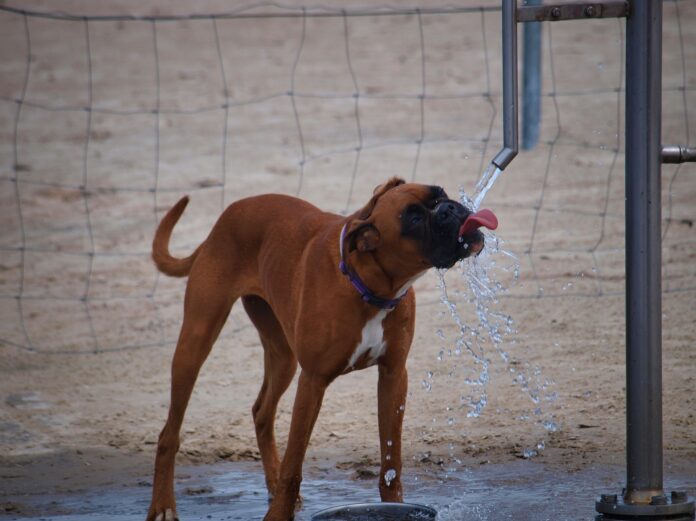CULLMAN, Ala. – The summer heat can be tough on everybody and that is especially true when it comes to our pets. The Tribune sat down with Dr. Susie Dickerson from Northside Veterinary Hospital in Cullman to better understand why our pets are at an increased risk for heatstroke or even death due to the summer’s high temperatures.
“One thing people don’t always think about is dogs, particularly the ones you see in cars, they are not like us,” Dickerson said. “They don’t sweat when they get hot to dissipate heat. They don’t have the sweat glands like we do. They do have some, but they don’t have near the amount that we do. When they start getting hot, they start panting, and panting is not a very good way to dissipate heat.”
Panting is not only a poor way for dogs to dissipate heat, Dickerson said the act of panting in some cases can cause a dog’s temperature to rise. Dogs and cats also have normal body temperatures that are higher than humans’. The normal temperature range for cats and dogs is 99-102.5 degrees.
Dickerson explained, “Have them in the car or something, that body temperature can go up super quick. After it’s at 106, it’s definitely a heatstroke. It’s really common for us to see pets, they are coming in during the summer and they have been in the car on the way to the vet. When they get worked up, their temperature gets to 104. That’s in the air conditioner or the back of the truck where they are getting air.”
If a routine trip to the vet can cause an increase in a pet’s body temperature, leaving them in the car while out and about is incredibly dangerous, she said. If a dog’s temperature gets to 108, the prognosis is not good.
Said Dickerson, “All their organs are pretty much cooked on the inside and there is just no coming back from that. It’s preventable, but I see it all the time, like Walmart or at restaurants, I’ll see dogs in cars with the windows cracked, but it’s HOT.”
The Alabama heat is especially dangerous for dogs kept outside.
Dickerson pointed out, “Even dogs that are at home, some things people don’t think about, are providing them with adequate shade. Dogs that are outside, if you see them in the morning and you think that they have shade, you have to remember the sun moves, and by afternoon when it’s really hot, the shade that they saw that they had in the morning might not be there in the afternoon.”
Another danger is to dogs kept on runners or ziplines. It is very easy for them to turn their water over or find themselves out of reach. Water left outside also heats up and becomes undrinkable. Dogs need to have cool clean water throughout the day. They will not drink water that has become too hot.
Another situation to think about is an outside dog getting excited by kids playing nearby or a lawnmower, and running excessively. This can cause heat stroke quickly in dogs.
Dickerson said, “We have had patients that are used to running or jogging with their owners, and it’s earlier in the spring and they are out running in the morning and they will have a heatstroke. Just try to keep in mind that they can’t keep up this time of year with the hotness and the humidity; it’s harder on them. Also remember, the pavement is really hot and they aren’t wearing shoes. They can burn their paw pads fairly easily. If it’s so hot that your hand isn’t on it, I wouldn’t put my dog on that.”
Dickerson said, with heatstroke, the quicker the dog can get to the vet the better.
“I would say that one thing that is lifesaving in those cases is people trying to get them cooled down on their way to the vet,” she said.
She suggested cooling them down with the water hose once the water runs cool to the touch. Also applying ice packs under their legs or to their jugular and putting a fan on them, adding, “Some are already passed out so they can’t swallow water, but if they are awake, offer them, not ice-cold water, but cool water is helpful.”
Oftentimes, once a dog’s temperature has exceeded 108, the pet can be stabilized but their organs will begin to shut down soon after. Dickerson does not recommend giving any over the counter medications because dogs and cats metabolize medications differently from humans, and it can also hinder a vet’s treatment for heatstroke.
She said, “I would always ask, ‘Can I give this?’ That’s where it comes in- have an established relationship with your vet. If you call, I know who you are and I know your animal. I have a general idea of their health and I can tell you for sure if you can give this Benadryl or this stomach medicine or what not. If I don’t know you and I don’t know your pet, I can’t give you any advice. Having that good relationship built where you come in once a year and seeing the pet, it’s important for stuff like that.”
Dickerson also suggested keeping a close eye on your pets during summer parties and cookouts.
“People can feed them from the table things they don’t normally have or guests will feed them something,” she said. “We see a lot of pancreatitis, diarrhea, upset stomachs from getting foods they aren’t supposed to have.”
Some foods can cause problems. For example, onions can cause anemia and grapes can cause kidney failure.
“These are foods you might see at a barbecue or a get-together,” said Dickerson.
There are several signs that your dog could be having a heat stroke:
- Heavy panting
- Excessive drooling
- Wanting to lie down
- Fast of irregular heartbeat
- Lethargy
- Vomiting and/or diarrhea
- Loss of appetite
- Neurological signs (stroke, stumbling)
Short-nosed breeds are at a higher risk of heat exhaustion and heatstroke. This includes Pugs, Boston Terriers and bulldogs. These breeds have a more difficult time regulating their body temperature and panting is harder for them. Dickerson recommended these dogs, especially, be kept inside and in the cool temperatures.
Copyright 2020 Humble Roots, LLC. All Rights Reserved.




















